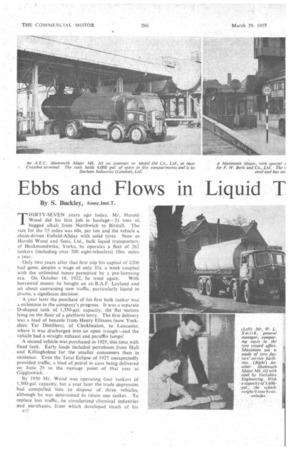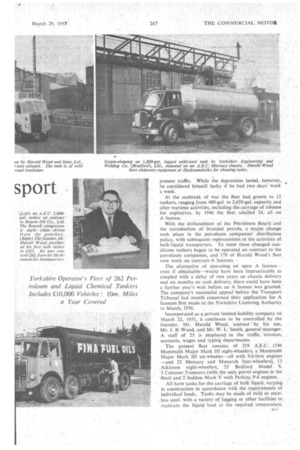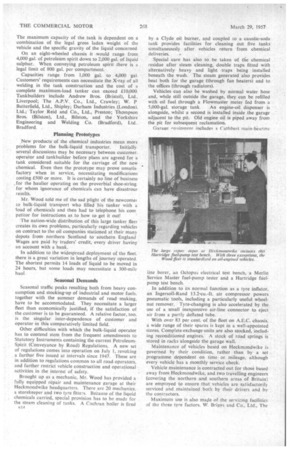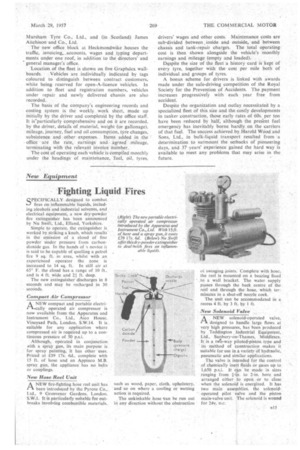Ebbs and Flows in Liquid T
Page 46

Page 47

Page 48

Page 49

If you've noticed an error in this article please click here to report it so we can fix it.
sport
By S. Buckley, Assucinst.T.
THIRTY-SEVEN years ago today, Mr. Harold Wood did his first job in haulage-31 tons of. bagged alkali from Northwich to Birstall. The rate for the 55miles was 60s. per ton and the vehicle a chain-driven Enfield-Allday with solid tyres. Now as Harold Wood and Sons, Ltd., bulk liquid transporters, of Heckmondwike, Yorks, he operates a fleet of 262 tankers (including over 200 eight-wheelers) 10m. miles a year.
Only two years after that first trip his capital of £200 had gone, despite a wage of only 35s. a week coupled with the unlimited hours permitted by a pre-licensing era. On October 18, 1922, he tried again. With borrowed money he bought an ex-R.A.F. Leyland and set about canvassing new traffic, particularly liquid in drums, a significant decision.
A year later the purchase of his first bulk tanker was a milestone in the company's progress. It was a separate D-shaped tank of 1,350-gal. capacity, the flat section lying on the floor of a platform lorry. The first delivery was a load of benzole from Henry Ellisons (now Yorkshire Tar Distillers), of Cleckheaton, to Lancaster, where it was discharged into an open trough—and the vehicle had a straight exhaust and paraffin lamps!
A second vehicle was purchased in 1925, this time with fixed tank. Early loads included petroleum from Hull and Killingholme for the smaller consumers then in existence. Even the Total Eclipse of 1927 unexpectedly provided traffic, a load of petrol in cans being delivered on June 29 to the vantage point of that year at Giggleswick. •
By 1930 Mr. Wood was operating four tankers of 1,500-gal. capacity, but a year later the trade depression had compelled him to dispose of three vehicles, although he was determined to retain one tanker. To replace lost traffic, he circularized chemical industries and merchants, from which developed much of his
RU present traffic. While the depression lasted, however, he con§idered himself lucky if he had two days' work a week.
At the outbreak of war the fleet had grown to 12 tankers, ranging from 400-gal. to 2,650-gal. capacity and after wartime activities, including the carriage of toluene for explosives, by 1946 the fleet totalled 24, all on A licence.
With the disbandment of the Petroleum Board and the introduction of branded petrols, a major change took place in the petroleum companies' distribution policy, with subsequent repercussions in the activities of bulk-liquid transporters. To meet these changed conditions tankers began to be operated on contract to the petroleum companies, and 178 of Harold Wood's fleet now work on contract-A .licences.
The alternative of operating on open A licence— even if obtainable—would have been impracticable as coupled with a delay of two years on chassis delivery and six months on tank delivery, there could have been a further year's wait before an A licence was granted.' The company's successful appeal before the Transport Tribunal last month concerned their application for A licences first made to the Yorkshire Licensing Authority in March, 1956.
Incorporated as a private limited-liability company on March 22, 1951, it continues to be controlled by the founder, Mr. Harold Wood, 'assisted by his son, Mr. J. B. Wood, and Mr. W. L. Smith, general manager. A staff of 23 is employed in the traffic, invoices, accounts, wages and typing departments.
The present fleet consists of 219 A.E.C. (196 Mammoth Major Mark III eight-wheelers, a Mammoth Major Mark III six-wheeler—all with 9.6-litre engines —and 22 Mercury and Monarch four-wheelers), 13 Atkinson eight-wheelers, 25 Bedford Model S, 3 Commer 7-tonn.ers (with the only petrol engines in the -fleet) and 2 Seddon Mark V with Perkins P.6 engines.
All have tanks for the carriage of bulk liquid, varying in construction in accordance with the requirements of individual loads. Tanks may be made of mild or stainless steel, with a variety of lagging or other facilities to maintain the liquid load at the required temperature. The maximum capacity of the tank is dependent on a combination of the legal gross laden weight of the vehicle and the specific gravity of the liquid concerned On an eight-wheeled chassis it would range from 4,000 gal. of petroleum spirit down to 2,000 gal. of liquid sulphur. When conveying petroleum spirit there is a legal limit of 800 gal. per compartment.
Capacities range from 1,000 gal. to 4,000 gal Customers' requirements can necessitate the X-ray of all welding in the tank construction and the cost of a complete maximum-load tanker can exceed £10,000. Tankbuilders include Andrew Bros. (Bristol), Ltd.. Liverpool; The A.P.V. Co., Ltd., Crawley; W. P Butterfield, Ltd., Shipley; Darham Industries (London). Ltd.; Taylor Reid and Co., Ltd., Preston; Thompson Bros. (BiIston), Ltd., Bilston, and the Yorkshire Engineering and Welding Co. (Bradford), Ltd.. Bradford.
Planning Prototypes
New products of the chemical industries mean more problems for the bulk-liquid transporter. Initially. several discussions may be necessary between customer. operator and tankbuilder before plans are agreed for a tank considered suitable for the carriage of the new chemical. Even then the prototype may prove unsatisfactory when in service, necessitating modifications costing .£500 or more. It is certainly no line of business . for the haulier operating on the proverbial shoe-string. for whom ignorance of chemicals can have disastrous results.
Mr. Wood told me of the sad plight of the newcomer to bulk-liquid transport who filled his tanker with a load of chemicals and then had to telephone his com petitor for instructions as to how to get it out!
The nation-wide distribution of this large tanker fleei creates its own problems, particularly regarding vehicles on contract to the oil companies stationed at their mar* depots from northern Scotland to southern England Wages are paid by traders' credit, every driver having an account with a bank.
In addition to the widespread deployment of the fleet. there is a great variation in lengths of journey operated. The shortest permits 14 loads of liquid to be moved in 24 hours, but some loads may necessitate a 300-mile haul.
Seasonal Demands
Seasonal traffic peaks resulting both from heavy consumption and stocking-up of industrial and motor fuels. together with the summer demands of road making. have to be accommodated. They necessitate a larger fleet than economically justified, if the satisfaction of the customer is to be guaranteed. A relative factor, too. is the singular inter-dependence of customer and operator in this comparatively limited field.
Other difficulties with which the bulk-liquid operator has to contend stern from the frequent amendments to Statutory Instruments containing the current PetroleumSpirit (Conveyance by Road) Regulations. A new set of regulations comes into operation on July 1, revoking a further five issued at intervals since 1947. These are in addition to regulations common to all road operators, and further restrict vehicle construction and operational activities in the interest of safety.
Brought up as a mechanic, Mr_ Wood has provided a fully equipped repair and maintenance garage at their Heckmondwike headquarters. There are 20 mechanics. a storekeeper and two tyre fitte7s. Because of the liquid chemicals carried, special provision has to be made for the steam cleaning of tanks. A Cochran boiler is fired R14 by a Clyde oil burner, and coupled to a caustic-soda tank provides facilities for cleaning out five tanks simultaneously after vehicles return from chemical deliveries. .
Special care has also to be taken of tlie chemical residue after steam cleaning, double traps fitted with alternatively heavy and light traps being installed beneath the wash. The steam generated also provides heat both for the garage (through fan heaters) and to the offices (through radiators).
Vehicles can also be washed by normal water hose and, while still outside the garage, they can be refilled with oil fuel through a Flowmaster meter fed from a 5,000-gal. storage tank. An engine-oil dispenser is alongside, whilst a second is installed inside the garage adjacent to the pit. Old engine oil is piped away from the pit for subsequent reclamation.
Garaae ow:inn-tent includes a Cuthbert main-bea rine
line borer, an Octopus electrical test bench, a Merlin Service Master fuel-pump tester and a Hartridge fuelpump test bench. • In addition to its normal function as a tyre inflator, an Ingersoll-Rand 13.2-cu.-ft. air compressor powers pneumatic tools, including a particularly useful wheelnut remover. Tyre-changing is also accelerated by the use of a small inexpensive air-line connector to eject air from a partly deflated tube.
With over 83 per cent, of the fleet on A.E.C. chassis, a wide range of their spares is kept in a well-appointed stores. Complete exchange units are also stocked, including reconditioned engines. A stock of road springs is stored in racks alongside the garage wall.
Maintenance of vehicles based on Heckmondwike is governed by their condition, rather than by a set programme dependent on time or mileage, although every vehicle has a monthly service check.
Vehicle maintenance is contracted out for those based away from Heckmondwike, and two travelling engineers (covering the northern and southern areas of Britain) are emptoyed to ensure that vehicles are satisfactorily serviced and maintained both by their drivers and by the contractors.
Maximum use is also maje of the servicing facilities of the three tyre factors. W. Briggs and Co., Ltd., The
Marsharn TyreCo., Ltd., and (in Scotland) James Aitchison and Co., Ltd.
The new office block at Heckmondwike houses the traffic, invoicing_accounts, wages and typing departments under one roof, in addition to the directors' and general manager's office.
Location of the fleet is shown on live Graphdex wall boards. Vehicles are individually indicated by tags coloured to distinguish between contract customers, white being reserved for open-A-licence vehicles. In addition to fleet and registration numbers, vehicles under repair and newly delivered chassis are. also recorded.
The basis of the company's engineering records and costing system is the weekly work sheet, made up initially by the driver and completed by the office staff. It is-particularly comprehensive and on it are recorded, by the driver, details of material, weight (or gallonage). Mileage, journey, fuel and oil consumption, tyre changes, subsistence and other expenses. Items added in .the Office are the rate, earnings and. agreed. mileage, terminating with the relevant invoice nnmber.
The cost of operating each vehicle is compiled monthly under the headings of maintenance, fuel, oil, tyres, drivers' wages and other costs. Maintenance costs are sub-divided .between , inside and outside, and between chassis and tank-repair charges. The total operating cost is then shown alongside the vehicle's 'monthly earnings and mileage (empty and loaded).
Despite the size of the fleet a history card is -kept of every tyre, together with the cost per mile both of individual and groups of tyres.
A bonus scheme for drivers is linked with awards made under the safe-driving competition of the Royal Society for the Prevention of Accidents. The payment increases progressively with each year free. from accident.
Despite the organization and outlay necessitated by a specialized fleet of this size and the costly developments in tanker construction, those early rates of 60s. per ton have been reduced by half, although the pres-ent fuel emergency has inevitably borne hardly on the carriers of that fuel. The sticeess achieved by Harold Woad and Sons, Ltd., in bulk-liquid transport resulted from a determination to surmount the setbacks of pioneering days, and 37 ..years' experience gained the hard way is available to meet any problems that may arise in the future.




























































































